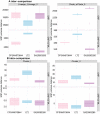Salmonella enterica subsp. enterica Welikade: guideline for phylogenetic analysis of serovars rarely involved in foodborne outbreaks
- PMID: 35303794
- PMCID: PMC8933937
- DOI: 10.1186/s12864-022-08439-2
Salmonella enterica subsp. enterica Welikade: guideline for phylogenetic analysis of serovars rarely involved in foodborne outbreaks
Abstract
Background: Salmonella spp. is a major foodborne pathogen with a wide variety of serovars associated with human cases and food sources. Nevertheless, in Europe a panel of ten serovars is responsible for up to 80% of confirmed human cases. Clustering studies by single nucleotide polymorphism (SNP) core-genome phylogenetic analysis of outbreaks due to these major serovars are simplified by the availability of many complete genomes in the free access databases. This is not the case for outbreaks due to less common serovars, such as Welikade, for which no reference genomes are available. In this study, we propose a method to solve this problem. We propose to perform a core genome MLST (cgMLST) analysis based on hierarchical clustering using the free-access EnteroBase to select the most suitable genome to use as a reference for SNP phylogenetic analysis. In this study, we applied this protocol to a retrospective analysis of a Salmonella enterica serovar Welikade (S. Welikade) foodborne outbreak that occurred in France in 2016. Finally, we compared the cgMLST and SNP analyses. SNP phylogenetic reconstruction was carried out considering the effect of recombination events identified by the ClonalFrameML tool. The accessory genome was also explored by phage content and virulome analyses.
Results: Our findings revealed high clustering concordance using cgMLST and SNP analyses. Nevertheless, SNP analysis allowed for better assessment of the genetic distance among strains. The results revealed epidemic clones of S. Welikade circulating within the poultry and dairy sectors in France, responsible for sporadic and non-sporadic human cases between 2012 and 2019.
Conclusions: This study increases knowledge on this poorly described serovar and enriches public genome databases with 42 genomes from human and non-human S. Welikade strains, including the isolate collected in 1956 in Sri Lanka, which gave the name to this serovar. This is the first genomic analysis of an outbreak due to S. Welikade described to date.
Keywords: Accessory genome analysis; ClonalFrameML; Core genome SNP analysis; EnteroBase analysis; Outbreak characterization; Phage analysis; Reference genome; Salmonella Welikade; Virulome analysis.
© 2022. The Author(s).
Conflict of interest statement
The authors declare that they have no conflict of interest.
Figures





References
MeSH terms
Supplementary concepts
LinkOut - more resources
Full Text Sources
Miscellaneous

